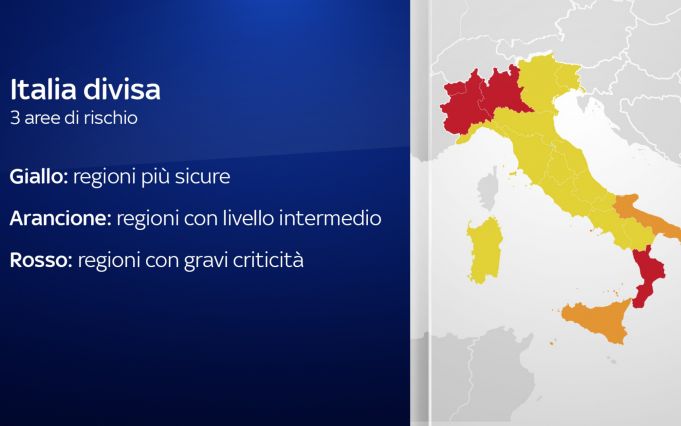Italy divided into red, orange and yellow zones under new covid-19 restrictions.
Italy has been divided into three areas under a new emergency decree to combat the second wave of
covid-19, with four high-risk areas declared red zones by the Italian premier Giuseppe Conte during a live televised address last night.
The three-tier system is based on a colour code according to the intensity of the epidemic, dividing the nation's 20 regions into red (high-risk), orange (medium risk) and yellow (low risk) zones.
The system comes into effect on 6 November and will be in place until 3 December. In addition there will be a nationwide curfew at night, between 22.00 and 05.00, in place until 3 December.
Museums and archaeological sites across Italy will also close from 6 November, with shopping malls closing on holidays and weekends nationwide.
The zone system had been due to take effect today, 5 November, but the government delayed to give businesses an extra day to adjust to the new measures.
Also the lower-risk zones were initially due to be green but Conte said this was changed to yellow to underline that caution is still required.
RED ZONES
Lombardia (Milan), Piemonte (Turin), Calabria, Valle d'Aosta
The most restrictive measures under the decree, including local lockdowns, will apply here. People will be prohibited from entering or leaving, or moving to other towns or cities within the zones. People may only leave their homes for reasons of necessity, such as work, health or taking children to school. Distance learning will apply to the final two years of middle school as well as high school. Bars, pubs, restaurants and most shops will be ordered to close. Food shops, pharmacies and hairdressers are allowed to remain open.
ORANGE ZONES
Puglia and Sicily
Restaurants and bars are closed but shops remain open. Distance learning will apply to senior high-school students. People can move freely within their towns and cities, but not leave them even to travel to other towns in the same region. It is forbidden to enter or leave the region.
YELLOW ZONES
Abruzzo, Basilicata, Campania (Naples), Emilia-Romagna (Bologna), Friuli Venezia Giulia, Lazio (Rome), Liguria, Marche, Molise, Sardinia, Trentino Alto-Adige, Tuscany, Umbria and Veneto (Venice).
The rest of Italy currently falls under the yellow category. In these zones there are no restrictions other than those imposed nationwide. Restaurants and bars are open until 18.00, and shops stay open as normal. Shopping centres are closed on weekends. It is possible to move within the region and from one yellow region to another.
Under Italy's last decree, issued on 24 October, the government closed theatres, cinemas, gyms and swimming pools. This led to protests across Italy from workers and small business owners who say they have not received adequate or any financial assistance from the state and now face bankruptcy.
The government is set to approve a new stimulus package worth at least €1.5 billion to support the economy, on top of last month's package of
€5.4 billion of measures to help the country's worst-hit businesses.
Photo credit: MikeDotta / Shutterstock.com.


















